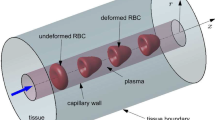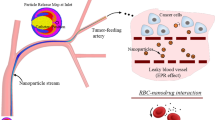Abstract
The small size of hemoglobin-based oxygen carriers (HBOCs) may expand the realm of new treatment possibilities for various circulatory diseases. The parametric evaluation of HBOC performance for oxygen transport within tissue is essential for effectively characterizing its performance for each circulatory disease assessed. Thus, the overarching objective of this present study was to numerically investigate the reaction–diffusion phenomenon of oxygenated HBOCs and oxygen on tissues through microvessels. We considered dissociation rate coefficients, oxygen affinity, and diffusion coefficients due to Brownian motion as the biophysical parameters for estimating HBOC performance for oxygen transport. A two-dimensional computational domain, including vessel and tissue regions, was, therefore, accordingly assumed. It was observed that HBOC flows in a microvessel with a diameter of 25 μm and a length of 1 mm, and that the dissociated oxygen diffuses to the tissue region. The results indicated that oxyhemoglobin saturation and partial oxygen tension in a downstream region changed according to each biophysical parameter of HBOC. Moreover, the change in oxygen consumption rate in the tissue region had considerable influence on the oxyhemoglobin saturation level within the vessel. Comparison between simulation results and existing in vitro experimental data of actual HBOCs and RBC showed qualitatively good agreement. These results provide important information for the effective design of robust HBOCs in future.




Similar content being viewed by others
References
Squires JE. Artificial blood. Science. 2002;295:1002–5.
Chang TM. Hemoglobin-based red blood cell substitutes. Artif Organs. 2004;28:789–94.
Winslow RM. Red cell substitutes. Semin Hematol. 2007;44:51–9.
Meng F, Tsai AG, Intaglietta M, Acharya SA. Pegylation of αα-Hb succinimidyl propionic acid peg 5K. Artif Cells Nanomed Biotechnol. 2015;43:270–81.
Natanson C, Kern SJ, Lurie P, Banks SM, Wolfe SM. Cell-free hemoglobin-based blood substitutes and risk of myocardial infarction and death: a meta-analysis. JAMA. 2008;299:2304–12.
Sakai H, Sou K, Horinouchi H, Kobayashi K, Tsuchida E. Haemoglobin-vesicles as artificial oxygen carriers: present situation and future visions. J Intern Med. 2008;263:4–15.
Sakai H, Sou K, Horinouchi H, Kobayashi K, Tsuchida E. Review of hemoglobin-vesicles as artificial oxygen carriers. Artif Organs. 2009;33:139–45.
Tomita D, Kimura T, Hosaka H, Daijima Y, Haruki R, Ludwig K, Bottcher C, Komatsu T. Covalent core-shell architecture of hemoglobin and human serum albumin as an artificial O2 carrier. Biomacromolecules. 2013;14:1816–25.
Oda T, Nakajima Y, Kimura T, Ogata Y, Fujise Y. Hemodilution with liposome-encapsulated low-oxygen affinity hemoglobin facilitates rapid recovery from ischemic acidosis after cerebral ischemia in rats. J Artif Organs. 2004;7:101–6.
George I, Yi GH, Schulman AR, Morrow BT, Cheng Y, Gu A, Zhang G, Oz MC, Burkhoff D, Wang J. A polymerized bovine hemoglobin oxygen carrier preserves regional myocardial function and reduces infarct size after acute myocardial ischemia. Am J Physiol Heart Circ Physiol. 2006;291:1126–37.
Kawaguchi AT, Fukumoto D, Haida M, Ogata Y, Yamano M, Tsukada H. Liposome encapsulated hemoglobin reduces size of cerebral infarction in the rat. Stroke. 2007;38:1626–32.
Isaka M, Imamura M, Sakuma I, Shiiya N, Ishizuka T, Ogata Y, Yasuda K. Experimental study of pegylated liposomal hemoglobin on norepinephrine release and reperfusion arrhythmias in isolated guinea pig hearts. Ann Thorac Cardiovasc Surg. 2007;13:391–5.
Matsumoto T, Asano T, Mano K, Tachibana H, Todoh M, Tanaka M, Kajiya F. Regional myocardial perfusion under exchange transfusion with liposomal hemoglobin: in vivo and in vitro studies using rat hearts. Am J Physiol Heart Circ Physiol. 2005;288:1909–14.
Plock JA, Rafatmehr N, Sinovcic D, Schnider J, Sakai H, Tsuchida E, Banic A, Erni D. Hemoglobin vesicles improve wound healing and tissue survival in critically ischemic skin in mice. Am J Physiol Heart Circ Physiol. 2009;297:905–10.
Hyakutake T, Tominaga S, Matsumoto T, Yanase S. Numerical study on flows of red blood Cells with liposome-encapsulated hemoglobin at microvascular bifurcation. J Biomech Eng Trans ASME. 2008;130:011014.
Hyakutake T, Akagi Y, Imaru T, Matsumoto T, Yanase S. Numerical study on effects of liposome-encapsulated hemoglobin on blood flows at microvascular bifurcation with considering erythrocyte aggregation. Int Fed Med Biol Eng Proc. 2010;31:1059–62.
Popel AS. Theory of oxygen transport to tissue. Crit Rev Biomed Eng. 1989;17:257–321.
Hellums JD, Nair PK, Huang NS, Ohshima N. Simulation of intraluminal gas transport processes in the microcirculation. Ann Biomed Eng. 1996;24:1–24.
Vadapalli A, Goldman D, Popel AS. Calculation of oxygen transport by red blood cells and hemoglobin solutions in capillaries. Art Cells Blood Subs Immob Biotech. 2002;30:157–88.
Tsoukias NM, Goldman D, Vadapalli A, Pittman R, Popel AS. A computational model of oxygen delivery by hemoglobin-based oxygen carriers in three-dimensional microvascular network. J Theor Biol. 2007;248:657–74.
Gundersen SI, Palmer AF. Hemoglobin-based oxygen carrier enhanced tumor oxygenation: a novel strategy for cancer therapy. Biotechnol Prog. 2008;24:1353–64.
Sakai H, Okuda N, Sato A, Yamaue T, Takeoka S, Tsuchida E. Hemoglobin encapsulation in vesicles retards NO and CO binding and O2 release when perfused through narrow gas-permeable tubes. Am J Physiol Heart Circ Physiol. 2010;298:956–65.
McNamara G, Zanetti G. Use of the Boltzmann equation to simulate lattice-gas automata. Phys Rev Lett. 1998;61:2332–5.
Succi S. The Lattice Boltzmann Equation. Oxford: Clarendon Press; 2001.
Inamuro T, Yoshino M, Inoue H, Mizuno R, Ogino R. A lattice Boltzmann method for a binary miscible fluid mixture and its application to a heat-transfer problem. J Comput Phys. 2002;179:201–15.
Bhatnagar PL, Gross EP, Krook M. A model for collision processes in gases. I. Small amplitude processes in charged and neutral one-component systems. Phys Rev. 1954;94:511–25.
Qian TH, d’Humiéres D, Lallemand P. Lattice BGK models for Navier-Stokes equation. Europhys Lett. 1992;17:479–84.
Sakai H, Tsai AG, Rohlfs RJ, Hara H, Takeoka S, Tsuchida E, Intaglietta M. Microvascular responses to hemodilution with Hb vesicles as red blood cell substitutes: influence of O2 affinity. Am J Physiol Heart Circ Physiol. 1999;276:H553–62.
Ellsworth ML, Popel AS, Pittman RN. Assessment and impact of heterogeneities of convective oxygen transport parameters in capillaries of striated muscle: experimental and theoretical. Microvasc Res. 1988;35:341–62.
Patton JN, Palmer AF. Numerical simulation of oxygen delivery to muscle tissue in the presence of hemoglobin-based oxygen carriers. Biotechnol Prog. 2006;22:1025–49.
Ye T, Phan-Thienb N, Lim CT. Particle-based simulations of red blood cells-A review. J Biomech. 2016;49:2255–66.
Hyakutake T, Nagai S. Numerical simulation of red blood cell distributions in three-dimensional microvascular bifurcations. Microvasc Res. 2015;97:115–23.
Acknowledgements
This research was partially supported by MEXT SPIRE Supercomputational Life Science.
Author information
Authors and Affiliations
Corresponding author
Ethics declarations
Conflict of interest
The authors confirmed that there are no known conflicts of interest associated with this publication and there has been no significant financial support for this work that could have influenced its outcome.
Rights and permissions
About this article
Cite this article
Hyakutake, T., Kishimoto, T. Numerical investigation of oxygen transport by hemoglobin-based carriers through microvessels. J Artif Organs 20, 341–349 (2017). https://doi.org/10.1007/s10047-017-0974-5
Received:
Accepted:
Published:
Issue Date:
DOI: https://doi.org/10.1007/s10047-017-0974-5




